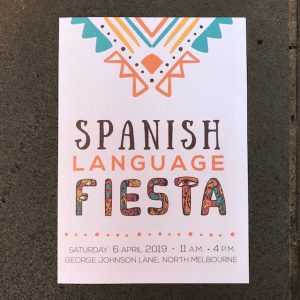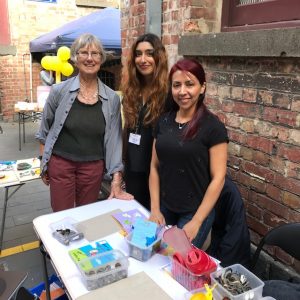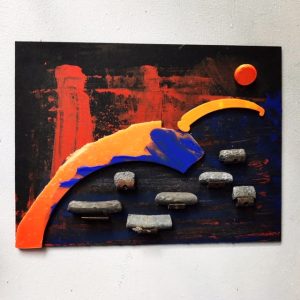What great fun at North Melbourne’s fourth annual Spanish Language Fiesta on 6 April 2019. The festival is sponsored by The Centre: Connecting Community in North and West Melbourne. The scheduled opening was at 11am, but visitors were already dropping by at 10.30.
During the first year of the fiesta, I ran a Spanish-language book exchange. This year I combined books and Spanish and found objects.
Children—and a few brave adults—created flatlays based on pictures in Spanish-language children’s books. They were made entirely from trash I had found on Melbourne’s streets.
Exhibiting in Spanish
In my small exhibition, La Ciudad, I showed four photos along with the wall sculptures based on them. These were Las Flores, La Ciudad, El Puente y Los Barcos, and Tres Globos Aerostáticos.
The aim of this mini-exhibition was to show participants how they could interpret physical items using trash. For example, a tyre balancing weight might become a ship in the harbour, or cream chargers could be balloons. In the artwork to the right, street cleaning bristles have become stems and nuts are flowers. The other three artworks from this exhibition are at the end of the post.
My assistants
I was very pleased that my friend Jasmin from Colombia was able to help me with this drop-in workshop. She is not only a native Spanish-language speaker, but surprisingly, a very good Taiko Japanese drummer.
We were also assisted by Avneet, another volunteer at the festival, who helped out when we got busy or needed to take breaks.
Inspirational flatlays from trash
The 18 children and two adults who made their own flatlays ranged in age from 1-1/2 to over 70 years. They were inspired by many different pictures and ideas from the Spanish-language children’s books we had borrowed from the North Melbourne Library and had available at the workshop.
Chris made a fish among seaweed, the seaweed being green cream chargers and pieces of plastic, which he called Baja la Mar. Jack made a colourful butterfly (Mariposa) before heading off on his scooter, while Zoe created a veritable obstacle course.
Inadvertently a model
Serge decided to make a curly-haired woman, whom he called ‘Nancy’. He didn’t know anyone named Nancy, nor did his mother. They were surprised and pleased, as was I, that that was my name. I only wish my hair was as blond and curly as was his flatlay Nancy’s hair!
La Ciudad, El Puente y Los Barcos, y Tres Globos Aerostáticos
These three wall sculptures, in English, mean The City, The Bridge and the Boats, and Three Hot Air Balloons.
I made The Bridge and the Boats collaboratively with Julia Zoellner, a German artist who spent a year living and working in Melbourne. It was initially exhibited previously in our joint exhibition, Upcycled from the City Streets.
Can you recognise which work is which, and what they have been made from?
I found the backing materials (laminated boards, natural boards and faux slate) in skips on the street, and the other materials on footpaths or the streets. These materials include rusted screws, a jeans stud, pieces of orange plastic, tyre balancing weights, cream chargers, and many small, rectangular pieces of metal.
Postscript, November 2019: Sadly, the coordinator of the Spanish Language Fiesta, Tatiana Echeverri, has left The Centre for a new position. Hopefully, however, the Spanish Language Fiesta will live on. Viva La Fiesta!







